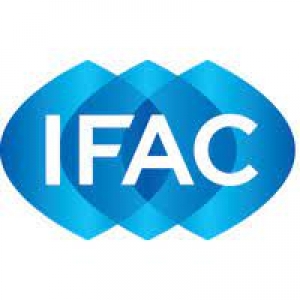عرض العناصر حسب علامة : التمويل
رسالة ماجستير: إستراتيجية البنوك في تمويل المؤسسات الصغيرة والمتوسطة
تعرف الساحة الإقتصادية اليوم سلسلة من التغيرات التي لم يسبق لها مثيل، هذه التغيرات التي تمثل فيها العولمة والشراكة الدولية والإقليمية وزيادة تحرير الأسواق أحد أهم مؤشراتها، جعلت من المرحلة الحالية تحميل الكثير من التغير الجذري في هذه البيئة التي تتم بالحركية واللايقين، غيرت الكثير من المعطيات سواء على المستوى الكلي (تغير البيئة الاقتصادية) أو على المستوى الجزئي (تغير إستراتيجيات المؤسسة).
معهد المحاسبين الإداريين يطلق برامج الشهادات للتثقيف في مجالين من مجالات الأعمال الناشئة
ستمنح برامج الاستدامة الجديدة وشهادة DE&I متخصصي المحاسبة والمالية الأدوات والمعرفة لمعالجة المشكلات في مؤسساتهم
رسالة دكتوراه: دراسة لأثر تطبيق معايير الإيجار التشغيلي على القوائم المالية والقرارات ذات الصلة
تعتبر عملية الاستئجار من أهم وسائل التمويل طويلة الاجل التي تستخدمها الشرکات کبديل للاقتراض لشراء الاصول، وذلک لتلبية احتياجاتها من الاصول لاستخدامها في عملياتها الانتاجية، وذلک إما لعدم توفر السيولة لدى الشرکة، أو رغبتها في الاحتفاظ بسيولتها، أو ارتفاع تکلفة الفرصة البديلة وبالتالي استخدام السيولة الفائضة لديها في فرص استثمارية أخرى
ندوة عبر الويب استكشاف الدور الحاسم للمدراء الماليين وفرق التمويل في التحول المناخي
تتطور ممارسة الإفصاح العلني عن خطط الانتقال بسرعة، ومع ذلك فإن عدد الشركات التي كشفت عن خطط شاملة أقل بكثير مما التزمت بالوصول إلى صافي الصفر أو تعهدت بالوصول إلى الحياد المناخي
معلومات إضافية
- البلد عالمي
- نوع الفعالية مجانا
- بداية الفعالية الأربعاء, 21 سبتمبر 2022
- نهاية الفعالية الأربعاء, 21 سبتمبر 2022
- التخصص محاسبة ومراجعة
- مكان الفعالية اونلاين
رسالة ماجستير: دور الأسواق المالية في دعم التنمية الاقتصادية
في الوقت الراهن والذي يتسم بالسعي المستمر لتطوير الإقتصاد وتنميته من طرف مختلف الدول والحكومات ووضعه كهدف إستراتيجي تطمح إلى تحقيقه بشتى الطرق، نجد بأن القدرة على دعمه تختلف من دولة إلى أخرى على حسب تطور وفعالية مصادر التمويل الموجودة بها وسبل تعاملها مع كل المتعاملين الإقتصاديين من خلال تعبئة مدخرات أصحاب الفوائض المالية من أشخاص طبيعيين ومعنويين وتوجيه هذه الموارد إلى أصحاب العجز لتمويل إحتياجاتهم الاستثمارية.
الهيئة السعودية تبدي وجهة نظرها في مشروع مجلس المعايير الدولية للمحاسبة بشأن الإفصاح عن ترتيبات تمويل الموردين
نشر مجلس المعايير الدولية للمحاسبة مشروعاً لإدخال تعديل على المعيار الدولي للمحاسبة رقم 7 والمعيار الدولي للتقرير المالي رقم 7
الروبوتات ليسوا محاسبين!
كُتب الكثير في العام الماضي عن أتمتة العمليات الروبوتية (RPA)، ولسبب وجيه. من خلال تسهيل التكامل الأوسع للأنظمة المالية المتباينة وتطبيقات البرامج، يُعد RPA مزيد من الكفاءة لمؤسسات التمويل والمحاسبة. ولكن هل الروبوتات بديل للمحاسبين كما أثبتت بعض المقالات؟
معلومات إضافية
-
المحتوى بالإنجليزية
Much has been written in the last year about robotic process automation (RPA), and for good reason. By facilitating broader integration of disparate financial systems and software applications, RPA promises more efficiency to finance and accounting organizations. But are robots a substitute for accountants, as some articles have attested? Not by a long shot.
RPA captures, manipulates and interprets transactional data flowing from myriad IT systems and applications, effectively taking these repetitive tasks from accountants. That’s a good thing, as it frees up the accounting staff to become strategic accountants. The “robots” liberate accountants to do what they have longed to do — make sense of the financial data to improve business decisions.
RPA is just the latest iteration in a long progression of F&A software tools designed to improve efficiency and data accuracy, including our own here at BlackLine. RPA extends the automated functionality of ERP systems beyond the range of application programming interfaces (commonly known as APIs) and simple object access protocol, which are used to integrate the ERP system with other IT applications. Instead of the customary weeks it takes to link these systems, RPA pares the time down to a matter of days.
Trends and Technologies Shaping the Future of Tax and Accounting
WOLTERS KLUWER
There are some studies, such as that by the Hackett Group, that suggest that automated tools may lead to a reduction in headcount. But robo-accountants are not actual accountants. Despite the enormous power and promise of digital solutions, there will always be a need for the human connection. Robots may replicate what people do, but they are unemotional, have no intuition and cannot be motivated in a common cause. They’re simply machines making routine work easier and more efficient.
Turning dislocation into transformation
Today’s accountants should not fear automation; rather, they should embrace these tools to become strategic accountants. When machines replace traditional forms of work, they simultaneously open the door to other options. People are liberated to be more creative, engaged and productive. Let the robots handle rote administrative processing. Accountants’ skills are far too nuanced to squander on such tasks.
A case in point is the competitive advantage of extracting deeper meaning from internal and exogenous financial data. The internet is inundated with millions of data sets that may have import in business decisions. Software can narrow the field, but someone has to interpret the data to determine where best to grow the business or pull back.
Accountants can perform this function, filtering and analyzing internal and exogenous business-related data to assist the CFO in making more informed and agile decisions. Armed with the accountants’ analyses, the CFO can make more astute bets on where to invest the company’s capital and where to restrict it.
The office of finance has always been the nexus of financial and other business-related data. In today’s blisteringly fast 24/7 global business environment, where change can happen overnight, this information is a vital currency that can improve market share, reduce strategic risks and widen margins. The problem is that CFOs have relied on purely historical business data in making resource allocation and other financial decisions. Accountants are an untapped resource to help make rapid sense of today’s numbers to ensure the company remains on course to achieve its strategic objectives. If this is not the case, the CFO has an enhanced opportunity to nimbly change direction to seize more profitable business opportunities elsewhere.
Do CFOs require such assistance? You bet they do. In a 2016 survey of 122 CFOs at large companies by Deloitte, the respondents stated that they spend more than one quarter (27 percent) of their time on company strategy. An equal amount of time is devoted to operations, identifying ways to improve organizational efficiency, balance costs and manage issues related to talent. Less than one quarter of the CFOs’ time is focused on traditional finance functions, such as accounting and financial reporting and control requirements.
كيف يمكن للتمويل المستدام أن يساعد في إزالة الكربون من الاقتصاد الحقيقي؟
لتمويل الانتقال إلى مستقبل مستدام، تحتاج المؤسسات المالية إلى تعميق معرفتها بالأعمال التجارية التي تمولها.
معلومات إضافية
-
المحتوى بالإنجليزية
To fund the transition to a sustainable future, financial institutions need to deepen their knowledge of the businesses they finance.
In brief
Banks, asset managers and insurers have set out their net-zero goals. To meet them, FIs need to fund ambitious transition pathways.
FIs that develop granular knowledge of sub-sector transition pathways will be able to structure financing in ways that incentivize tangible climate action.
To position themselves successfully as transition finance providers, FIs will need to invest in a workforce skilled at analyzing sub-sector pathways.
COP26 will be remembered as the moment when finance moved to the forefront of the fight against climate change. Political surprises — ranging from the "phasing down" of coal to closer cooperation between the US and China — may have grabbed attention. But for the business community, it was finance that generated the headlines.
The global financial services industry has a critical role to play in achieving net zero targets by midcentury. Estimates for the investments required to transition the energy sector alone by 2050 range from between US$3.5 trillion (pdf) and US$5.8 trillion per year. At COP26, former Bank of England Governor Mark Carney announced that 450 major banks, asset managers and institutional investors representing up to US$130 trillion in assets have joined the Glasgow Financial Alliance for Net Zero (GFANZ), with a commitment to align their lending and investment portfolios to Paris Agreement climate goals.
Financial institutions (FIs) recognize that the transition to net zero will involve more than simply investments and underwriting for “green” assets and businesses such as renewables and electric vehicles. In order to achieve net zero across the whole economy, browner, more carbon intensive assets and companies will require financing to help them transition to green. For many businesses, the transition will mean a fundamental change to their operations — and to make those changes happen, they will need capital. Insurers, lenders and investors will play a crucial role in making that capital available and in incentivizing and supporting their clients and investees as they make their transitions.
As the IPCC’s sixth assessment report made abundantly clear earlier this year, rapid action is needed if we are to mitigate against the worst effects of climate change. The report reiterated the need to limit warming to below 1.5˚C and warned that despite these pledges, the IEA claimed that collectively they would only limit average temperature increases to 2.1˚C by the end of the century, which is not even in alignment with the lesser ambition of the Paris Agreement. The IEA’s estimates are optimistic. According to the UN’s latest annual Emissions Gap report, also published in October, climate commitments and plans from national governments are currently aligned with a 2.7˚C temperature increase.
New pledges made in Glasgow, if delivered, could take the world on a trajectory to 1.8˚C of warming at best. However, as stressed by the International Energy Agency (IEA) who analyzed the targets, implementing them will be key and is by no means a given. At a macro level, domestic implementation will mean increased disclosure and transparency requirements, greater scrutiny of targets and transition plans, and consolidation of sustainability reporting frameworks.
How EY can help
Sustainability and supply chain advisory
Our teams can help you understand risks to supply chains such as human rights issues, resource constraints, climate change and government payments.
Read more
Risks and returns
The material risks of climate change — sea level rise, biodiversity loss, drought, wildfires, floods and loss of life — are themselves a compelling reason to act on the transition. To act on climate change is to act in the interests of people and the planet. But as well as their duties to society, FIs are ultimately structured around financial returns. They have a fiduciary duty to identify and protect their shareholders from foreseeable risks that might affect those returns. Failing to act on climate change would increase those risks substantially — and could reduce global annual economic output by $23 trillion by mid-century, according to research by SwissRe. As Emma Herd, EY Oceania Partner for Climate Change and Sustainability Services explains, “the core obligation [of financial services] is to respond to market information and to manage risk and to lean into economic trends, and climate change and sustainability is the biggest economic trend of this century.”
But the transition to net zero will not merely be about risk mitigation, it will also represent a tremendous opportunity for FIs. John Kerry, the U.S. Special Presidential Envoy for Climate, has called the energy transition “a vast commercial opportunity as well as a planetary imperative.” Furthermore, the transition to a low-carbon economy is projected to aid economic growth. A joint analysis by the International Energy Agency and the International Monetary Fund estimates investments in the clean energy transition will add an extra 0.4% to global GDP each year. Under a net-zero pathway, global GDP would be 4% higher by 2030 as compared to other models.
FIs acting early on the transition will be able to take advantage of this global economic opportunity first and they will be paving the way to a more profitable future. But to really grasp this transition opportunity with both hands, EY believes that FIs need to focus on a series of practical steps across the lifecycle of an investment, loan or underwriting process that will enable FIs to better evaluate transition plans at a sector and sub-sector level.
التخطيط الاستراتيجي وقت الازمات
لم تقم التكنولوجيا بتزويدنا بكرة بلورية بعد، لذلك لا يمكن لأحد ان يرى المستقبل ولكن بالنسبة للذين يشغلون مناصب قيادية مالية من الضروري ان نجعل التخمينات الأكثر تعليماً ممكنة وأن يتم تصحيحها في كثير من الأحيان
القيمة المالية للعلامة التجارية
الأصول غير الملموسة هي المحرك الرئيسي لخلق قيمة تجارية طويلة الأجل في بيئة اليوم التنافسية والمترابطة وسريعة الحركة










